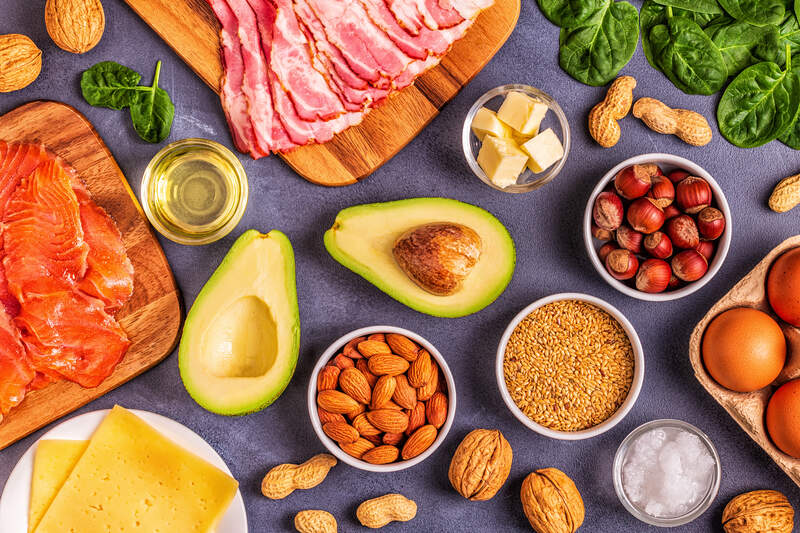What Is the Keto Diet, Really - And Should I Try It?
We've talked about the Paleo diet in a previous article, and thought it would be useful to discuss another very popular dietary approach you may be curious (or confused) about: the keto diet. You may have heard that it's all about eating fat, or maybe that you can't eat any carbs — let's break it down a bit more, starting from its origins, to who it may or may not be helpful for, as well as what the keto diet may look like for you.

What exactly is the keto diet?
The ketogenic diet is a high-fat, moderate-protein and very low-carbohydrate diet. While carbohydrates are often maligned in today's diet culture, they are the body's preferred source of energy, meaning your body will use carbohydrates first if they're available. For many people, especially those with specific illnesses or who have an abundance of body fat and are looking to lose some, a higher-carb diet can exacerbate their issues. On a strict ketogenic diet, the aim is to have around 5 percent of your energy intake, or percentage of calories, from carbohydrates. This near-elimination of carbs essentially forces the body into a metabolic state called ketosis, which is when your body breaks down body fat into molecules called ketone bodies (produced in the liver) to use for energy.
Once the body reaches ketosis, it will generally continue to use ketones for energy until you start eating carbohydrates again. Ideally, healthy people are “metabolically flexible” and can switch between fat burning and sugar burning relatively seamlessly, but they must do the work of becoming fat adapted first (more on this in a future article!).
American physician and medical researcher Russel Wilder first used the ketogenic diet (a term he coined) to treat epilepsy in 1921. Originally, this approach existed as a successful therapeutic, medical diet for treatment of pediatric epilepsy. There is research being done into its efficacy for other conditions like cancer, diabetes, PCOS, and cardiovascular disease, and it has found new popularity more recently as a rapid weight loss approach, and is seen by many as a healthier option than our modern, carb-heavy diet.
For strict medical ketosis, fat intake should be around 70-80% of total calories, carbohydrate intake should be between 5-10% of total calories, and protein should fall within the range of 10-20% of total calories. For the average person trying keto to lose weight, this can range from 25-75 grams of carbs daily, or even higher if the person is very active.
So what does a keto diet look like for me?
Similar to Paleo, you'll want to avoid things like grains, sugar, baked goods, chips, and other processed “junk” foods, but you'll also be minimizing starchy vegetables like potatoes and high-sugar fruits like bananas and mangoes. Many keto eaters do still incorporate starchy fruits and vegetables into their diet, just in much smaller amounts than, for example, a typical Paleo eater who is not aiming for ketosis.
The fact that the keto diet is a higher-fat approach to eating often gets misinterpreted to mean we should aim to eat as much fat as possible – this is inaccurate, and can lead to digestive issues, weight gain, and other problems if you're taking in very high amounts of dietary fat, especially from suboptimal sources.
Some standard keto meals may include: an omelet with eggs, spinach, mushrooms, and Swiss cheese and a coffee with heavy cream; a salad with salmon and a generous sprinkling of nuts, feta, and avocado or olive oil-based dressing; a lettuce-wrapped burger with cauliflower mash topped with butter, and maybe a snack of nuts or a nut-butter based “fat bomb.” It is not necessarily a low-calorie diet, and doesn't have to be particularly restrictive; while some keto eaters will have to avoid most carb sources, there is still more you can eat than can't – and it's also more about amounts than cutting anything out completely. Many keto eaters also “cycle” their carbs, or strategically eat slightly more carbohydrate around their workouts or on highly active days.
What are the pros?
There is evidence that a therapeutic ketogenic diet is beneficial for people with epilepsy, Alzheimer's, Type 2 diabetes, and some other conditions.
If you struggle with energy swings and carb cravings, it may be easier to cut out those hyper-palatable foods altogether, especially if they aren't nutrient-dense. A healthy low-carb diet can support weight loss, improve energy, and eliminate energy crashes throughout the day. And when done well with a focus on real, nutrient-dense foods, a keto diet can help improve health, performance, and body composition.

What are the cons?
If you are used to a higher protein or higher carb approach, it can seem restrictive. And if you make the switch to keto style eating abruptly, many people experience a period of adaptation known as the “keto flu” with symptoms like low energy, headaches, and constipation, although that usually goes away in a few days.
Some people may find that it is easy to overconsume calories eating keto, leading to weight gain even if they feel they're eating healthier or eating less food. This is largely because fat is the most calorie-dense macronutrient: 9 calories per gram rather than the 4 calories per gram of protein and carbs. And while fat is satiating, it's still easy to overconsume tasty high-calorie foods like butter, cream, nuts and nut butters, and keto baked goods.
Which leads to the next point: nearly any diet can be done in a suboptimal way, and in this case, there's the “dirty keto” approach which prioritizes “hitting macros” over nutrient density and health – basically, you can eat anything as long as you're eating low-carb. This often results in a diet that is high in fat but low in nutrition, as the priority is on eating high-fat foods rather than nutrient-dense ones. An approach with a wide variety of protein sources, low carb veggies, and fewer processed foods is going to meet your macro goals as well as provide needed nutrients.
If you are a highly active person, are pregnant or breastfeeding, a low-carb diet may not be ideal for you. The brain operates on glucose/carbohydrate, and low carb diets can result in brain fog and mood swings. In some cases, a high fat diet can result in liver problems as that is where fat is metabolized, and depending on your dietary choices, nutrient deficiency can be a concern if you aren't eating a variety of foods.
So how do I start?
If you decide you'd like to try a keto-style, or just low-carb approach, we think gradual tweaks to your current diet is the best way to go. By making slow, incremental changes, you will increase your chances of adherence, understand how your body actually responds to those changes, and you'll be less likely to experience negative side-effects like the keto flu. If you normally have a serving or two of healthy carbs with every meal, you may want to start by cutting carbs from only one meal a day and see how it impacts your energy and hunger. You can then continue to cut the carbs as desired, making sure you're still getting enough calories to support your body function and daily activity, and adding in healthy fat sources with every meal, things like butter, olive oil, coconut, avocado, nuts and seeds, healthy cheese or dairy products, and higher-fat animal protein like chicken thighs, steak, eggs, and salmon. (We also want to add a caveat that it's a good idea to discuss any dietary changes with your health care provider.)
It's important to know that you don't have to be “in ketosis,” producing ketones, or eating fewer than 20 grams of carbs a day to be healthy; many people will notice health benefits simply by reducing carbs and eating more healthy fats. We think that the best dietary approach is one that is full of nutrient-dense foods we enjoy, supports our lifestyle, and still allows for flexibility and fun — and it's up to you to decide what that looks like.
Resources:
What Is Keto? Simple Guide for Beginners
The Potential Health Benefits of the Ketogenic Diet: A Narrative Review